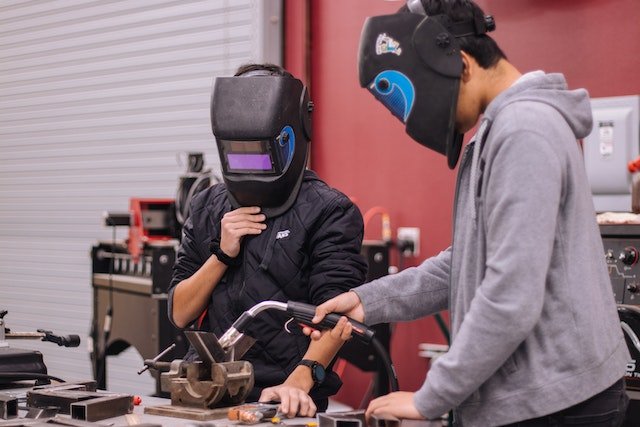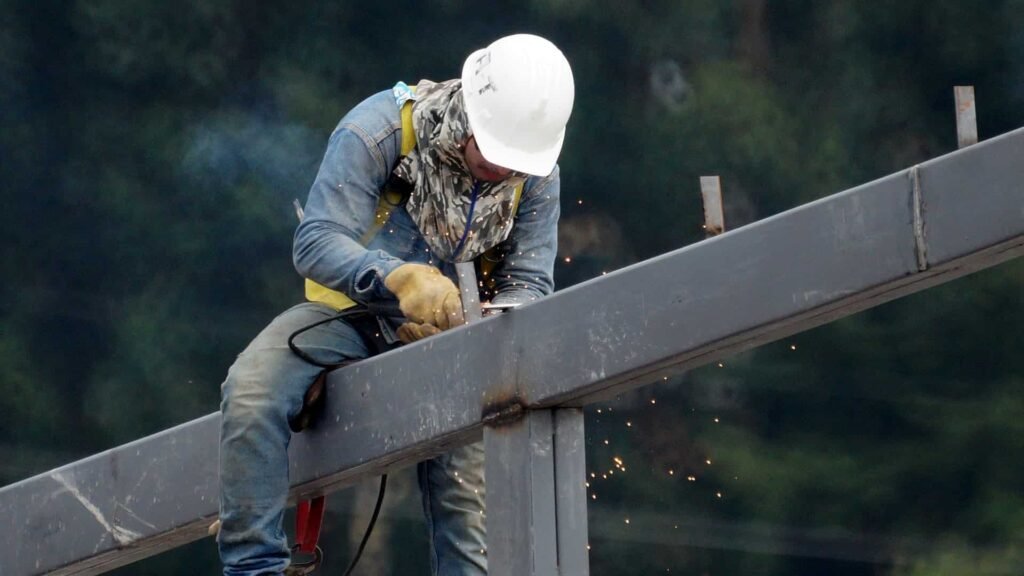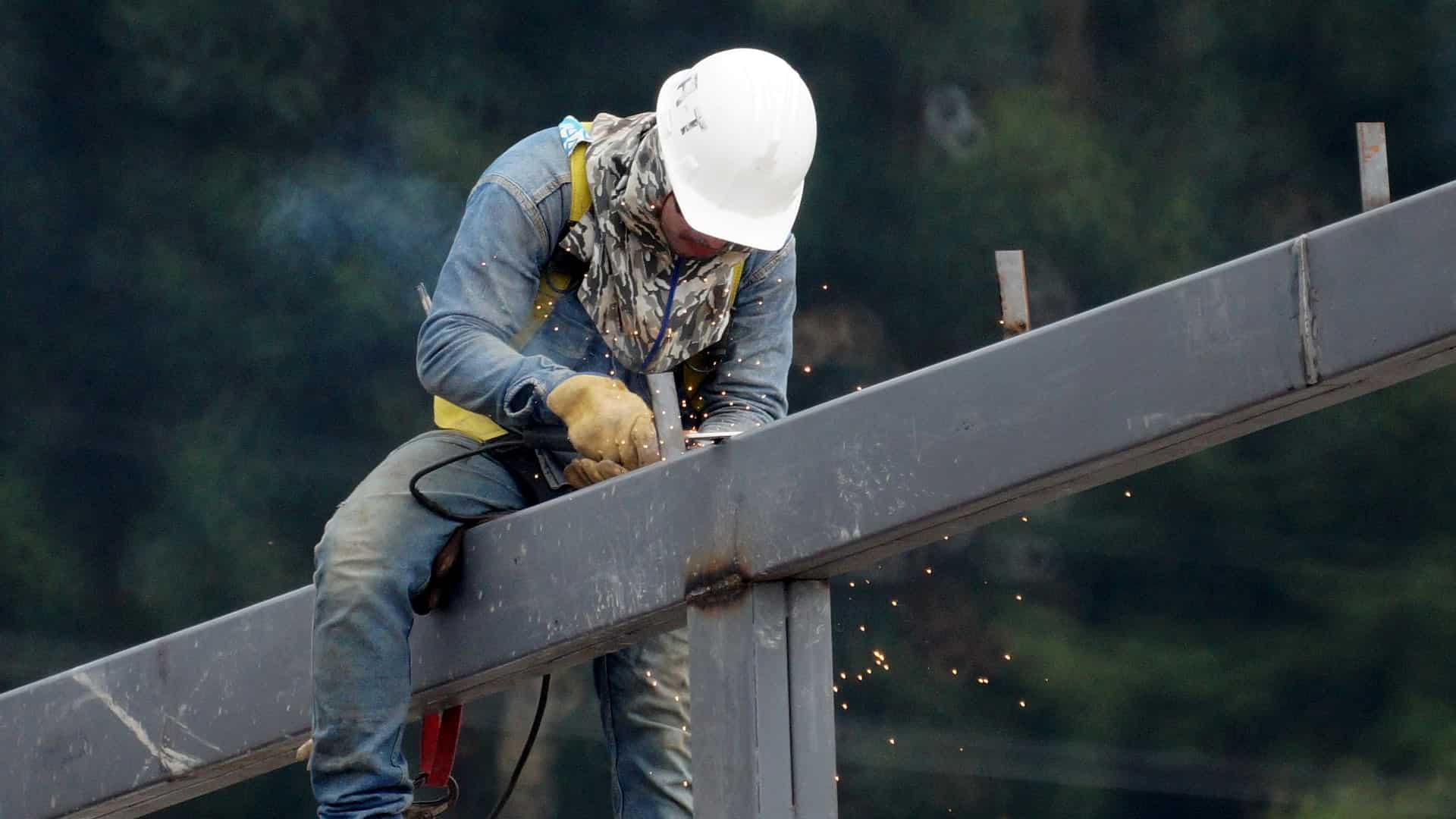Welding is an indispensable process in various industries, from construction to manufacturing, where metals are joined together to create strong and durable structures.
While it is a crucial skill, it also comes with inherent risks that demand strict adherence to safety protocols.
Neglecting welding safety rules can lead to severe injuries, property damage, and even fatalities.
In this blog, we will explore all crucial welding safety rules that every welder should follow to protect themselves and others in their work environment.
16 Best Welding Safety Tips & Rules You Must Know

1. Personal Protective Equipment (PPE):
Personal Protective Equipment is the first line of defence against potential welding hazards.
Welders must always wear appropriate gear, including a welding helmet with a proper shade lens, safety glasses, a fire-resistant welding jacket, gloves, and steel-toed boots.
PPE helps shield the welder from sparks, splatter, UV radiation, and harmful fumes that can cause injuries or long-term health problems.
2. Give Augmented Reality Or Virtual Reality Welding Training to newbies
Implementing AR Welding or Virtual Reality Welding Training for newcomers enhances welding safety by providing immersive, hands-on experiences. This innovative approach allows novices to practice welding techniques in a simulated environment, ensuring they develop the necessary skills while minimizing risks associated with live welding processes.
3. Adequate Ventilation:
Welding produces toxic fumes and gases that can be harmful when inhaled. Working in a well-ventilated area is essential to prevent the accumulation of hazardous fumes.
If working indoors, ensure the workspace is equipped with adequate exhaust systems, fans, or ventilation hoods to remove fumes effectively.
4. Fire Safety:

Welding generates intense heat, and a small spark can ignite flammable materials. Always remove combustible materials from the welding area and keep a fire extinguisher within reach.
It is also wise to have a designated fire watch personnel during and after welding operations to prevent potential fire hazards.
Check Out Our Complete Module For VR Fire Safety Training
6. Safe Handling of Welding Equipment:
Before starting any welding task, it is crucial to inspect the welding equipment for defects, damaged cables, or loose connections.
Faulty equipment can lead to accidents or create subpar welds. Additionally, always ensure that the welding machine is turned off when not in use to prevent unintended arcing.
Check Out Our Services: Workplace VR Safety Training
7. Preparing the Work Area:
Maintaining a clean and organized work area is essential for safety. Remove clutter, debris, and other hazards from the vicinity to minimize tripping or slipping accidents. Adequate lighting in the work area is also crucial to ensure precise welding and reduce eye strain.
8. Proper Grounding:
Grounding the welding circuit is vital to protect the welder from electric shock. Ensure that the workpiece and welding equipment are correctly grounded to create a safe path for electrical currents.
9. Training and Certification:
Welding is a skill that requires training and practice. All welders should undergo proper training and be certified in their welding techniques. Experienced welders must guide beginners to ensure they understand safety protocols and industry best practices.
10. Handling Compressed Gas Cylinders:
Compressed gas cylinders, such as oxygen and acetylene, are commonly used in welding. Safely handling these cylinders is critical to prevent leaks or explosions. Store cylinders in an upright position, secure them with chains or straps and avoid exposing them to extreme heat or flame.
11. Protecting Against Electric Shock:

Electric shock is a significant risk in welding. Avoid touching the electrode or metal parts of the welding circuit without proper protection. Insulate yourself from the workpiece and ground, and use dry gloves to reduce the risk of electric shock.
Providing VR Electric Training to employees significantly enhances safety by offering immersive learning experiences.
12. Proper Welding Position:

Maintain a stable and comfortable welding position to reduce fatigue and ensure better control over the welding process. Awkward positions may lead to unstable welds and increase the likelihood of accidents.
13. Regular Maintenance of Equipment:
Regularly inspect and maintain welding equipment to ensure its proper functioning. Replace damaged or worn-out parts promptly to prevent breakdowns during critical welding tasks.
14. Proper Storage of Welding Electrodes:
Welding electrodes are susceptible to moisture absorption, which can affect their performance and create welding defects.
Store electrodes in a dry and controlled environment, such as a heated electrode oven, to prevent moisture contamination. Always use electrodes before their expiration date, and keep them in sealed containers when not in use.
14. Eye Protection:
Welding produces intense UV radiation, which can cause severe eye injuries, including arc eye or welder’s flash.
In addition to wearing a welding helmet with a proper shade lens, welders should consider using safety goggles with side shields to protect their eyes from flying debris and sparks. Regular eye check-ups are crucial to detect any early signs of eye damage caused by welding.
15. Safe Handling of Hot Workpieces:
After welding, the workpiece and surrounding area can remain extremely hot. Avoid direct contact with hot metal to prevent burns and use appropriate tools, such as pliers or gloves, to handle the workpiece until it has sufficiently cooled down.
Also, mark or barricade the area around hot workpieces to warn others of potential burn hazards.
16. Precautions for Confined Spaces:

Welding in confined spaces presents additional risks, such as inadequate ventilation and the accumulation of hazardous fumes. Before entering a confined space, perform proper air testing to ensure safe conditions.
Establish a rescue plan and have personnel stationed outside the confined space to assist in case of emergencies.
Delivering Virtual Reality Confined Spaces Training to employees significantly improves safety by immersing them in realistic scenarios, fostering a better understanding of confined space hazards and protocols.
By incorporating these additional welding safety rules into your workplace practices, you can create a culture of safety and reduce the likelihood of accidents or injuries associated with welding operations.
Always stay informed about the latest safety guidelines and industry best practices to maintain a safe and productive welding environment.
5 Benefits of Welding Safety Training
- Reduced Workplace Accidents: Proper safety training reduces the risk of workplace accidents, preventing injuries to welders and other personnel working in the vicinity.
- Compliance with Regulations: Welding safety training ensures compliance with safety regulations and standards, helping organizations avoid fines and legal liabilities.
- Increased Productivity: Well-trained welders are more efficient and productive, as they can work confidently and safely without interruptions or accidents.
- Cost Savings: Investing in welding safety training saves money in the long run by reducing healthcare costs, insurance premiums, and expenses associated with workplace accidents and injuries.
- Enhanced Reputation: Prioritizing welding safety training demonstrates a commitment to employee well-being and professionalism, enhancing the organization’s reputation and attracting top talent.
FAQ’s
What are the basic safety rules in welding?
Welding requires strict adherence to safety guidelines to prevent accidents and injuries. Some essential safety rules include wearing appropriate personal protective equipment (PPE) like a welding helmet, gloves, and fire-resistant clothing. Ensure proper ventilation to remove hazardous fumes and gases.
Inspect welding equipment before use, and maintain a clean and organized work area to minimize tripping hazards.
Always ground the welding circuit and handle compressed gas cylinders with care. Proper training, certification, and knowledge of welding techniques are crucial for safe welding practices.
What are the 5 major safety concerns while welding?
The five major safety concerns in welding are:
Electric Shock: Welding involves high electrical currents, and improper handling can lead to severe electric shocks.
Fire and Burns: Sparks and heat generated during welding can cause fires and burn injuries.
Exposure to Fumes and Gases: Inhaling toxic fumes and gases released during welding can pose serious health risks.
Eye Injuries: Welding produces intense UV radiation that can damage the eyes, leading to arc eye or other injuries.
Trip and Slip Hazards: Cluttered or poorly maintained workspaces increase the risk of tripping and slipping accidents.
What 6 things are needed to be safe while welding?
1) Personal Protective Equipment (PPE): Welders should wear appropriate gear, such as a welding helmet, gloves, safety glasses, and fire-resistant clothing.
2) Adequate Ventilation: Proper ventilation systems should be in place to remove hazardous fumes and gases from the workspace.
3) Safe Handling of Equipment: Regularly inspect and maintain welding equipment to prevent accidents caused by faulty machinery.
4) Grounding: Proper grounding of the welding circuit protects welders from electric shock. e. Fire Safety: Keep fire extinguishers nearby and remove flammable materials from the welding area.
5) Training and Certification: Proper training and certification ensure knowledge of safe welding practices.
6) Organized Work Area: Maintain a clean and clutter-free workspace to minimize hazards and prevent tripping accidents.
Final Thoughts:
Welding safety is a paramount concern for every welder and those working in the vicinity. Adhering to these 15 essential welding safety rules can significantly reduce the risk of accidents, injuries, and health hazards associated with welding.
Always prioritize safety, invest in proper training, and maintain a vigilant approach to create a secure working environment for yourself and your colleagues.
By embracing these safety rules, welders can enjoy a fulfilling career in this dynamic field while safeguarding their well-being and that of others around them. Stay safe and weld with confidence!

